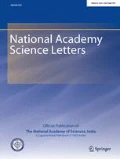Abstract
Stinging nettle (Urtica dioica L.) is an ecologically and economically important multipurpose perennial shrub of family Urticaceae. Here, we report heavy infestation by caterpillars of Indian tortoiseshell (Aglais caschmirensis aesis Fruhstorfer, 1912) on leaves of the plant at Pithoragarh, Uttarakhand, located in the Western Himalayan region. The infestation resulting in complete defoliation was recorded from April to November in the years 2020 and 2021. A life cycle study revealed 30 days as the life span of the insect. The insect may be an important component of the Integrated Weed Management system to manage the plant where its growth is undesired. Alternatively, an Integrated Pest Management system needs to be developed for sustainable management of the insect.


References
Oliver F, Amon EU, Breathnach A, Francis DM, Sarathchandra P, Black AK, Greaves MW (1991) Contact urticaria due to the common stinging nettle (Urtica dioica)–histological, ultrastructural and pharmacological studies. Clin Exp Dermatol 16:1–7
Adhikari BM, Bajracharya A, Shrestha AK (2015) Comparison of nutritional properties of Stinging nettle (Urtica dioica) flour with wheat and barley flours. Food Sci Nutr 4:119–124
Randall C, Meethan K, Randall H, Dobbs F (1999) Nettle sting of Urtica dioica for joint pain—an exploratory study of this complementary therapy. Clin Trial Complement Ther Med 7:126–131
Kregiel D, Pawlikowska E, Antolak H (2018) Urtica spp: ordinary plants with extraordinary properties. Molecules 23:1664
Varshney RK, Smetacek P (2015) A synoptic catalogue of the butterflies of India. Butterfly Research Centre, Bhimtal and Indinov Publishing, New Delhi, ii + 261 pp., 8 pl. ISBN: 978-81-929826-4-9
Arif M, Kumar N (1995) Serious pests of Urtica divica Linn at 5500’ altitude in Kumaon hills in India. Entomol Record J Var 107:13–14
Acknowledgements
The authors are grateful to Dr. Mohammad Arif, Ex. Scientist, Defence Institute of Bio-Energy Research, Haldwani, Uttarakhand, India, for help in taxonomic identification of the insect species. Financial support from Defence Research & Development Organisation, New Delhi, India, is gratefully acknowledged.
Significant statement
The present correspondence reports a life cycle study of an insect Indian tortoiseshell (Aglais caschmirensis aesis) that causes heavy infestation on stinging nettle (Urtica dioica L.), an economically and ecologically important medicinal shrub of the Western Himalaya.
Funding
Funding was provided by Defence Research and Development Organisation (Grant No. DIB-78).
Author information
Authors and Affiliations
Corresponding author
Additional information
Publisher's Note
Springer Nature remains neutral with regard to jurisdictional claims in published maps and institutional affiliations.
Rights and permissions
About this article
Cite this article
Patade, V.Y., Singh, N. & Bala, M. Heavy Infestation by Indian Tortoiseshell Caterpillars (Aglais caschmirensis aesis) on Stinging Nettle (Urtica dioica L.) Plants at Kumaon Hills of the Western Himalaya. Natl. Acad. Sci. Lett. 45, 441–444 (2022). https://doi.org/10.1007/s40009-022-01156-0
Received:
Revised:
Accepted:
Published:
Issue Date:
DOI: https://doi.org/10.1007/s40009-022-01156-0

